Fabrication and Evaluation of Embroidery-Based Electrode for EMG Smart Wear Using Moss Stitch Technique
Abstract
:1. Introduction
2. Experimental
2.1. Materials
2.2. Embroidery Design for sEMG Moss Electrodes
2.3. Preparation for Leg Sleeves with Moss sEMG Electrodes
2.4. Characterization
2.4.1. Tactile Properties of Moss Electrodes
2.4.2. Clothing Pressure of the Moss sEMG Electrodes
2.4.3. Electrical Properties of Moss sEMG Electrodes
2.4.4. sEMG Measurement and Data Processing
2.4.5. Data Analysis and Statistics
3. Results and Discussion
3.1. Tactile Properties of Moss sEMG Electrodes
3.2. Clothing Pressure of Moss sEMG Electrodes
3.3. Electrical Properties of the Moss sEMG Electrodes
3.4. sEMG of the Raw Signal and Average Rectification of the Moss sEMG Electrodes
4. Conclusions
Author Contributions
Funding
Institutional Review Board Statement
Informed Consent Statement
Data Availability Statement
Conflicts of Interest
References
- Wallace, G.G.; Campbell, T.E.; Innis, P.C. Putting function into fashion: Organic conducting polymer fibres and textiles. Fibers Polym. 2007, 8, 135–142. [Google Scholar] [CrossRef]
- Choudhry, N.A.; Arnold, L.; Rasheed, A.; Khan, I.A.; Wang, L. Textronics—A Review of Textile-Based Wearable Electronics. Adv. Eng. Mater. 2021, 23, 2100469. [Google Scholar] [CrossRef]
- Khilari, V.; Akash, P.; Samarth, A. WEARTRONICS-A Review of Wearable Technologies in Smart Textiles. Res. J. Sci. Technol. 2017, 9, 675–685. [Google Scholar] [CrossRef]
- Cai, L.; Song, A.Y.; Li, W.; Hsu, P.C.; Lin, D.; Catrysse, P.B.; Cui, Y. Spectrally selective nanocomposite textile for outdoor personal cooling. Adv. Mater. 2018, 30, 1802152. [Google Scholar] [CrossRef] [PubMed]
- Ismar, E.; Bahadir, S.K.; Kalaoglu, F.; Koncar, V. Futuristic clothes: Electronic textiles and wearable technologies. Glob. Chall. 2020, 4, 1900092. [Google Scholar] [CrossRef] [PubMed]
- Bosowski, P.; Husemann, C.; Quadflieg, T.; Jockenhövel, S.; Gries, T. Classified Catalogue for Textile Based Sensors. Adv. Sci. Technol. 2012, 80, 142–151. [Google Scholar]
- Guo, L.; Sandsjö, L.; Ortiz-Catalan, M.; Skrifvars, M. Systematic review of textile-based electrodes for long-term and continuous surface electromyography recording. Text. Res. J. 2020, 90, 227–244. [Google Scholar] [CrossRef]
- Lynn, S.K.; Watkins, C.M.; Wong, M.A.; Balfany, K.; Feeney, D.F. Validity and reliability of surface electromyography measurements from a wearable athlete performance system. J. Sports Sci. Med. 2018, 17, 205–215. [Google Scholar]
- Ortiz-Catalan, M.; Brånemark, R.; Håkansson, B.; Delbeke, J. On the viability of implantable electrodes for the natural control of artificial limbs: Review and discussion. Biomed. Eng. Online 2012, 11, 1–24. [Google Scholar] [CrossRef]
- Euler, L.; Guo, L.; Persson, N.-K. A review of textile-based electrodes developed for electrostimulation. Text. Res. J. 2022, 92, 1300–1320. [Google Scholar] [CrossRef]
- Xu, P.J.; Zhang, H.; Tao, X.M. Textile-structured electrodes for electrocardiogram. Text. Prog. 2008, 40, 183–213. [Google Scholar] [CrossRef]
- He, X.; Lin, Y.; Ding, Y.; Abdullah, A.M.; Lei, Z.; Han, Y.; Yu, K. Reshapeable, rehealable and recyclable sensor fabricated by direct ink writing of conductive composites based on covalent adaptable network polymers. Int. J. Extrem. Manuf. 2021, 4, 015301. [Google Scholar] [CrossRef]
- Li, Z.; Li, H.; Zhu, X.; Peng, Z.; Zhang, G.; Yang, J.; Lan, H. Directly printed embedded metal mesh for flexible transparent electrode via liquid substrate electric-field-driven jet. Adv. Sci. 2022, 9, 2105331. [Google Scholar] [CrossRef] [PubMed]
- Goncu-Berk, G.; Tuna, B.G. The effect of sleeve pattern and fit on e-textile electromyography (EMG) electrode performance in smart clothing design. Sensors 2021, 21, 5621. [Google Scholar] [CrossRef] [PubMed]
- Pitou, S.; Michael, B.; Thompson, K.; Howard, M. Hand-made embroidered electromyography: Towards a solution for low-income countries. Sensors 2020, 20, 3347. [Google Scholar] [CrossRef] [PubMed]
- Kim, H.; Kim, S.; Lim, D.; Jeong, W. Development and characterization of embroidery-based textile electrodes for surface EMG detection. Sensors 2022, 22, 4746. [Google Scholar] [CrossRef] [PubMed]
- Kim, H.; Rho, S.; Lim, D.; Jeong, W. Characterization of embroidered textile-based electrode for EMG smart wear according to stitch technique. Fash. Text. 2023, 10, 32. [Google Scholar] [CrossRef]
- Lim, D.; Lee, S.; Rho, S. Technical Embroidered E-Textile Products, 1st ed.; Gyommon: Paju, Republic of Korea, 2022. [Google Scholar]
- Sztandera, L.M.; Cardello, A.V.; Winterhalter, C.; Schutz, H. Identification of the most significant comfort factors for textiles from processing mechanical, handfeel, fabric construction, and perceived tactile comfort data. Text. Res. J. 2013, 83, 34–43. [Google Scholar] [CrossRef]
- Kim, N.Y.; Lee, H. Influence of clothing pressure on blood flow and subjective sensibility of commercial sports compression wear. Fash. Text. Res. J. 2019, 21, 459–467. [Google Scholar] [CrossRef]
- Uhlir, A., Jr. The potentials of infinite systems of sources and numerical solutions of problems in semiconductor engineering. Bell Syst. Tech. J. 1955, 34, 105–128. [Google Scholar] [CrossRef]
- Smits, F.M. Measurement of sheet resistivities with the four-point probe. Bell Syst. Tech. J. 1958, 37, 711–718. [Google Scholar]
- Kang, J.H.; Yu, K.M.; Kim, W.S. Development of Hand-Held Type Sheet Resistance Meter Based on a Dual-Configuration Four-Point Probe Method. Trans. Korean Inst. Electr. Eng. P 2010, 59, 423–427. [Google Scholar]
- Stauffer, F.; Thielen, M.; Sauter, C.; Chardonnens, S.; Bachmann, S.; Tybrandt, K.; Peters, C.; Hierold, C.; Vörös, J. Skin conformal polymer electrodes for clinical ECG and EEG recordings. Adv. Healthc. Mater. 2018, 7, 1700994. [Google Scholar] [CrossRef]

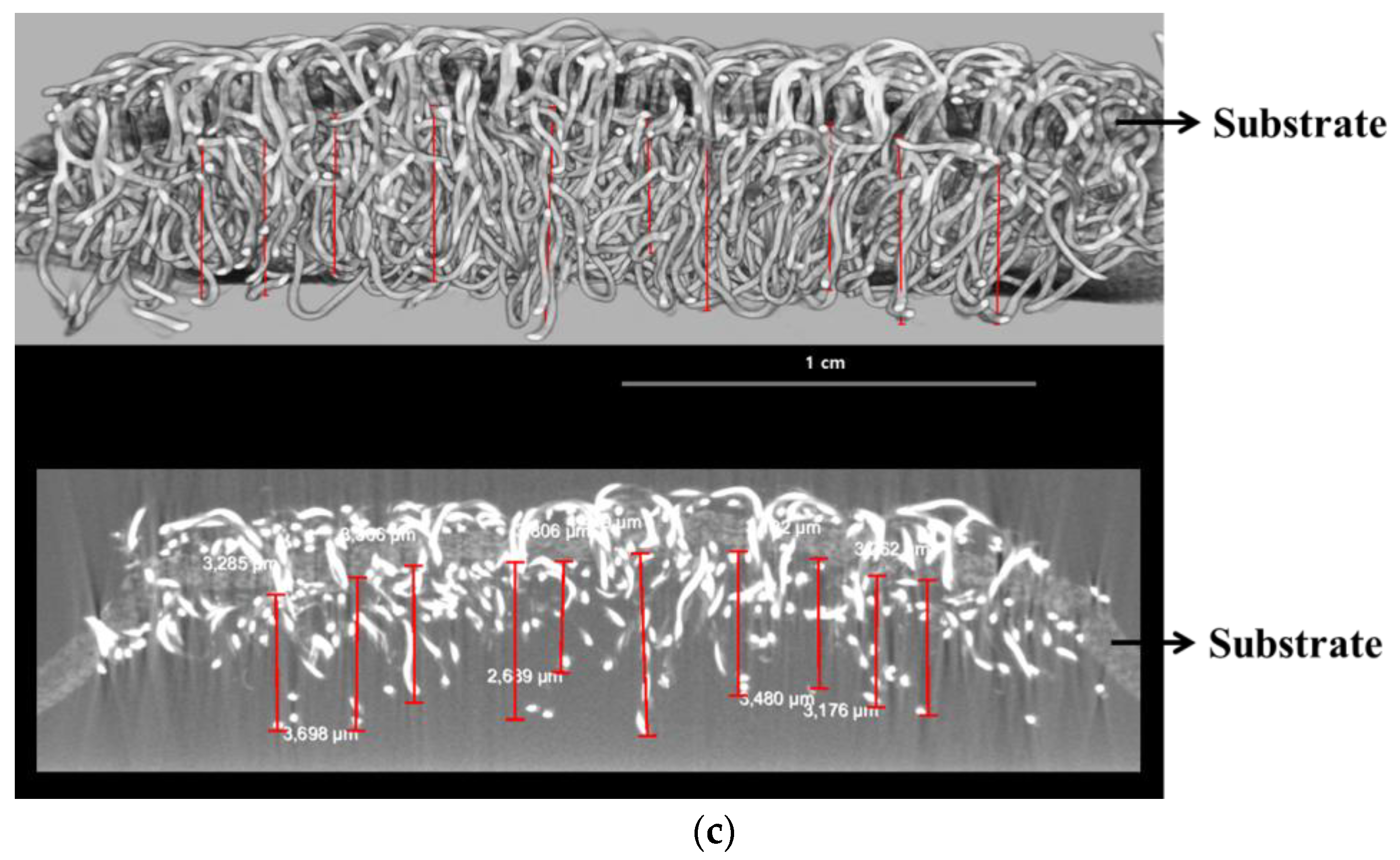
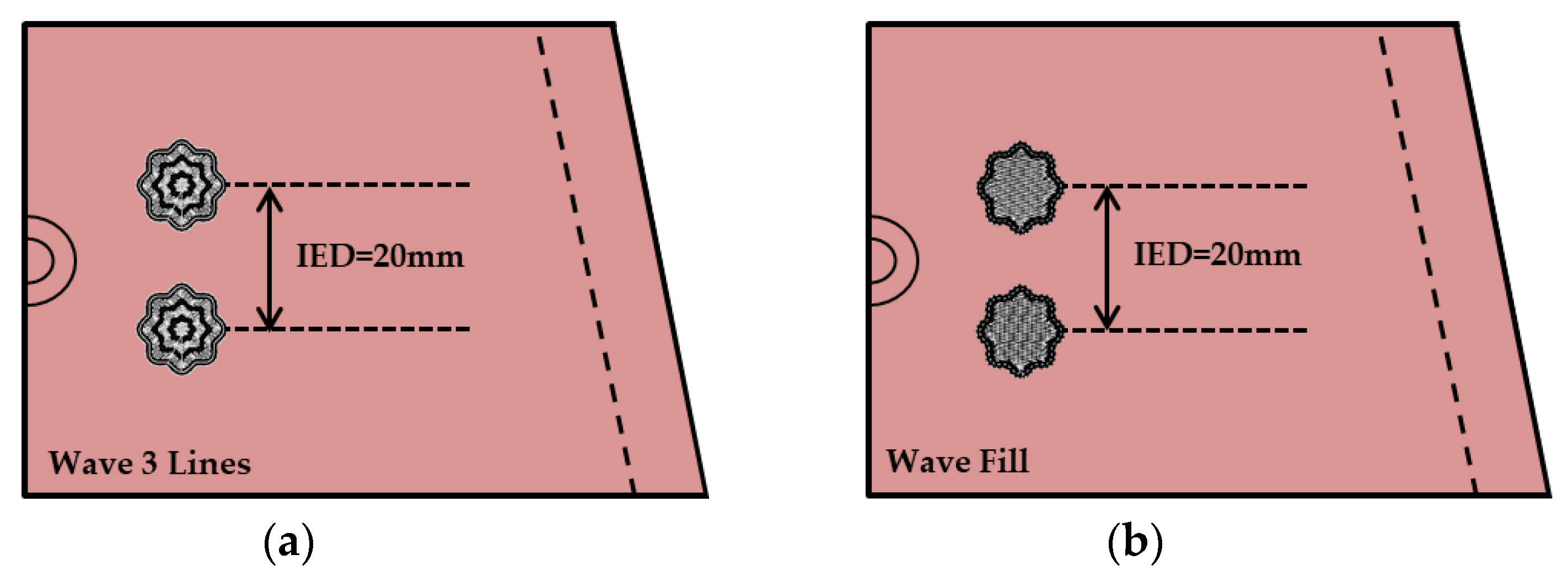

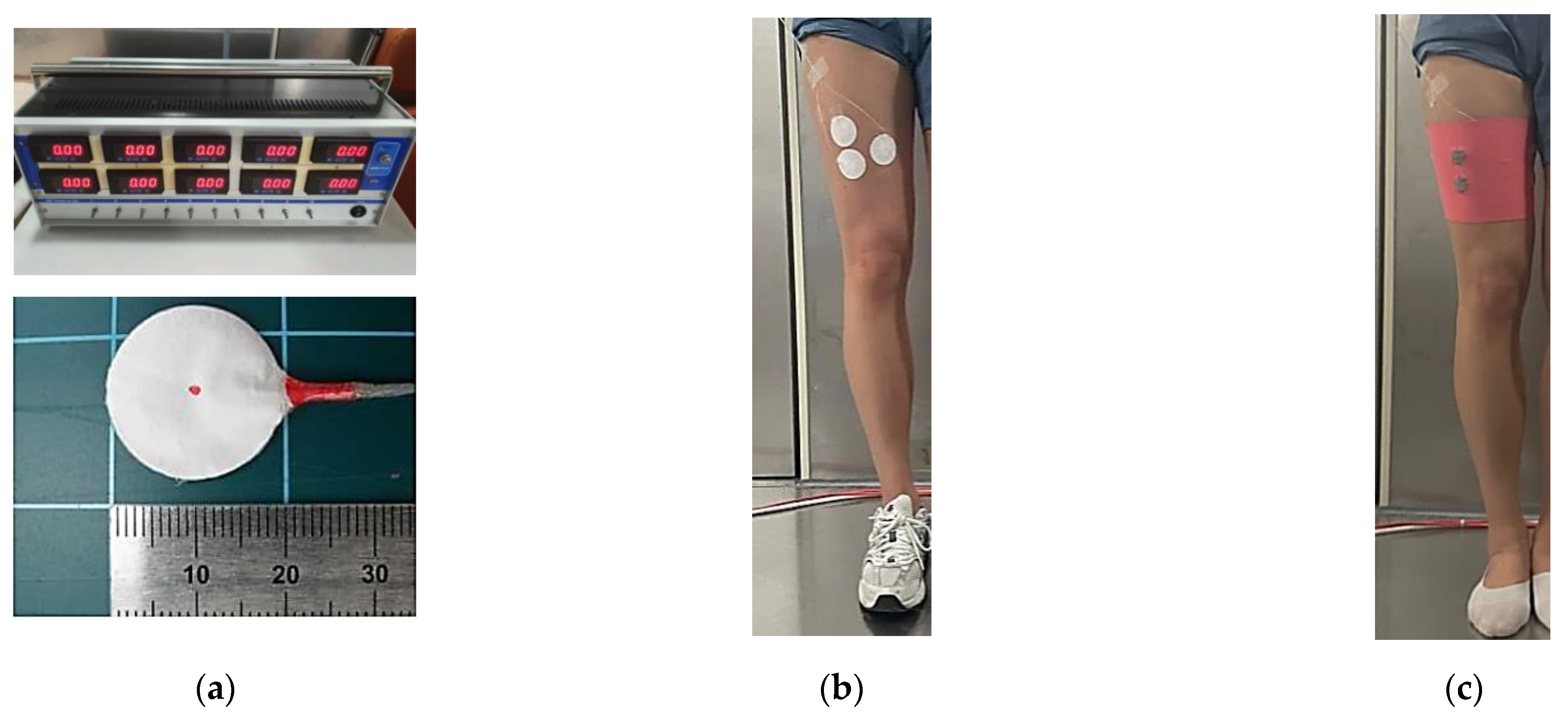
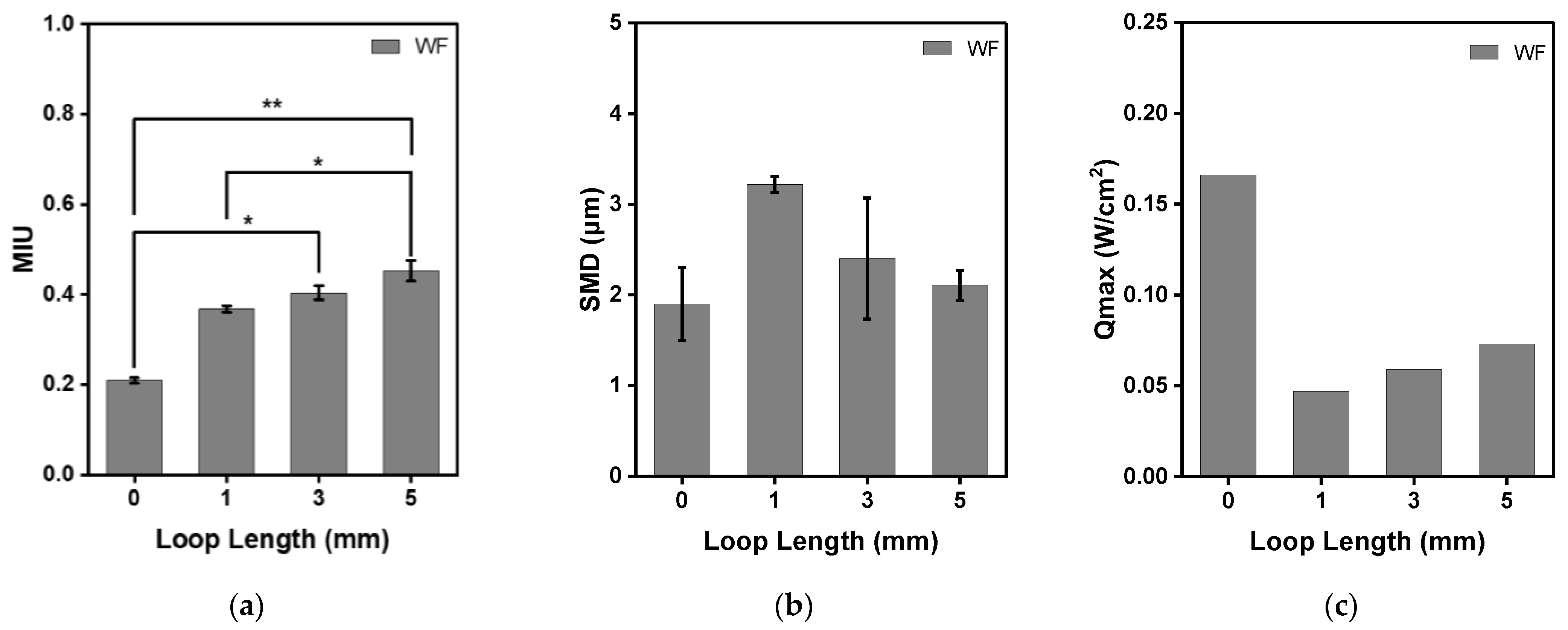
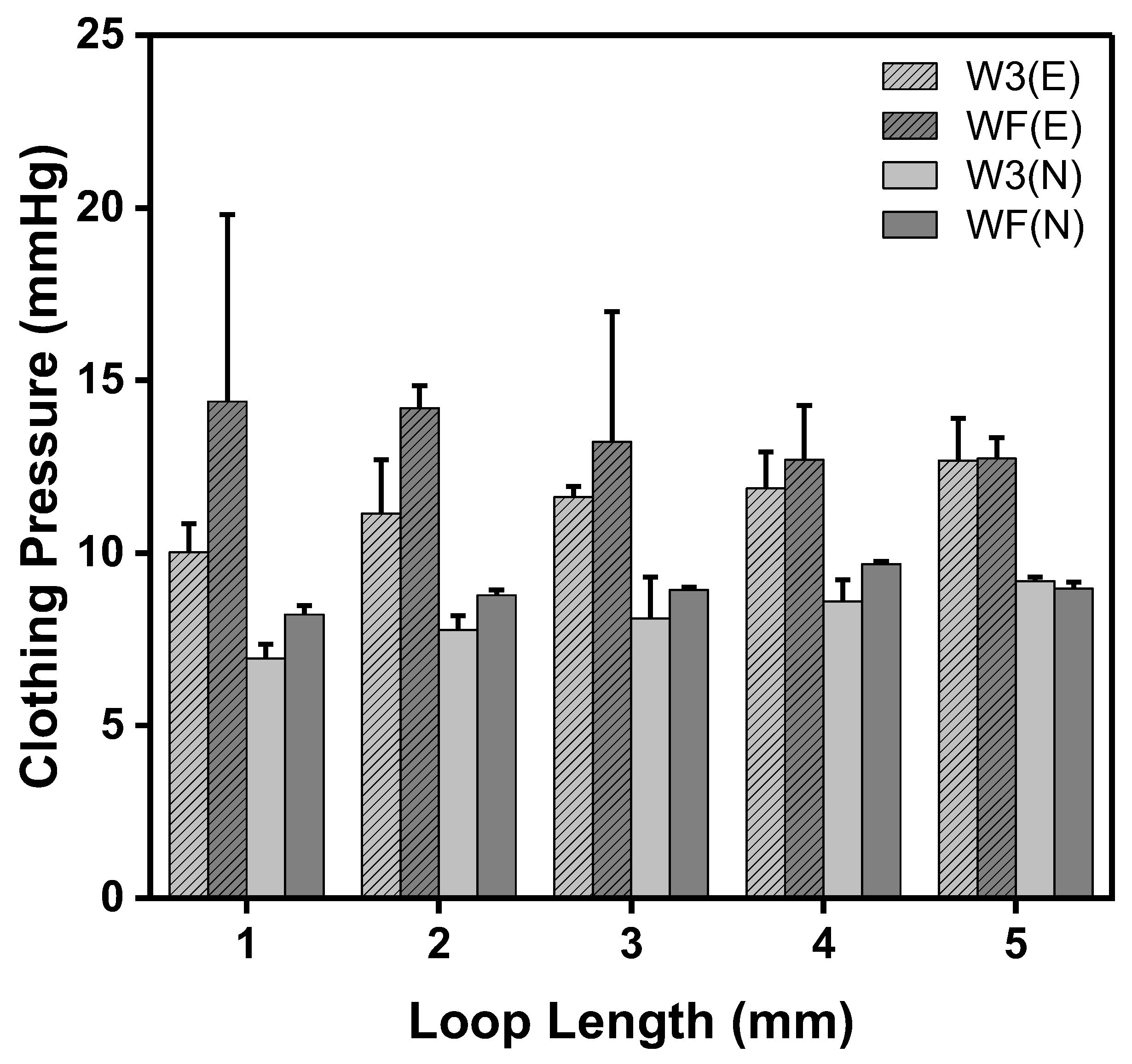

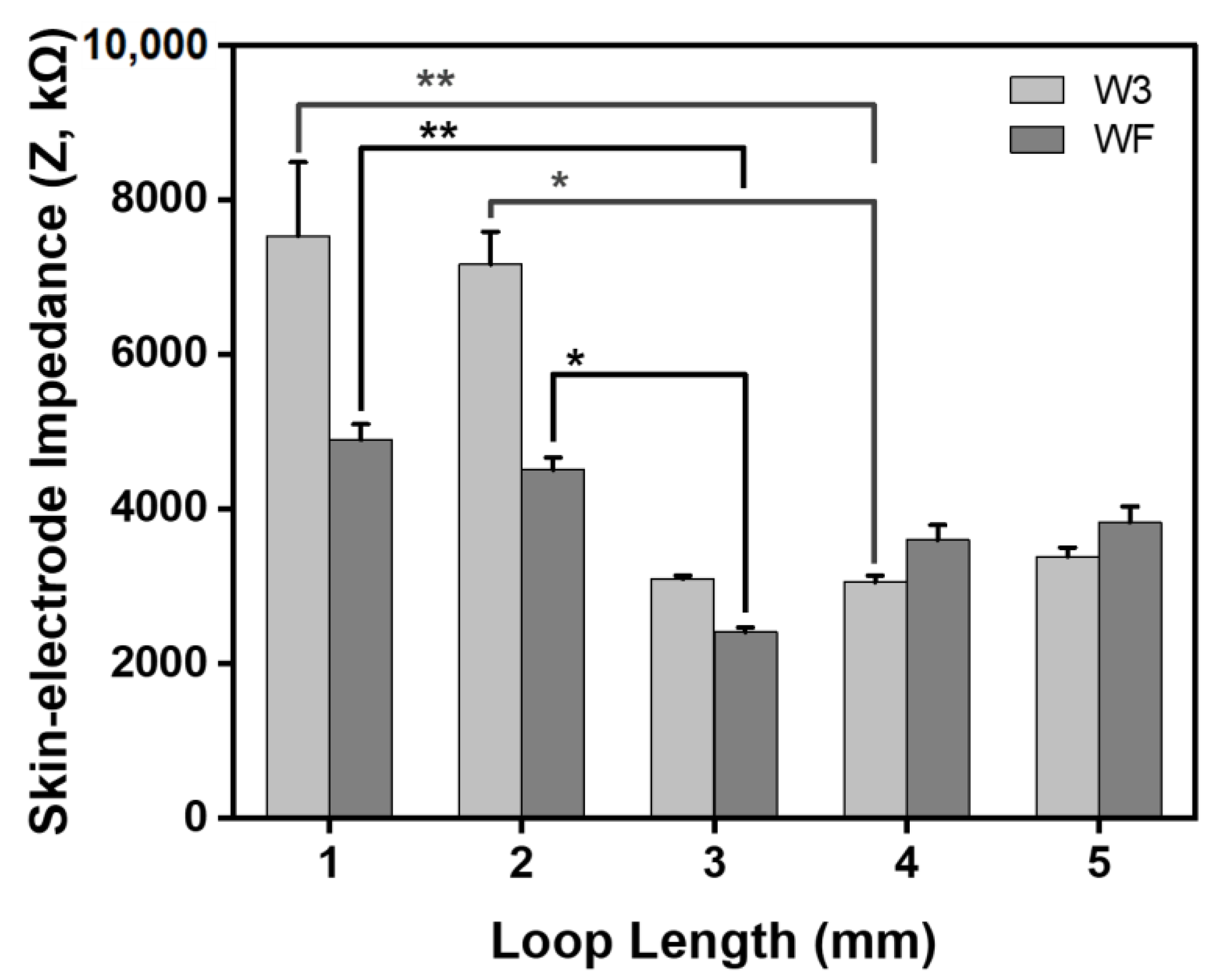
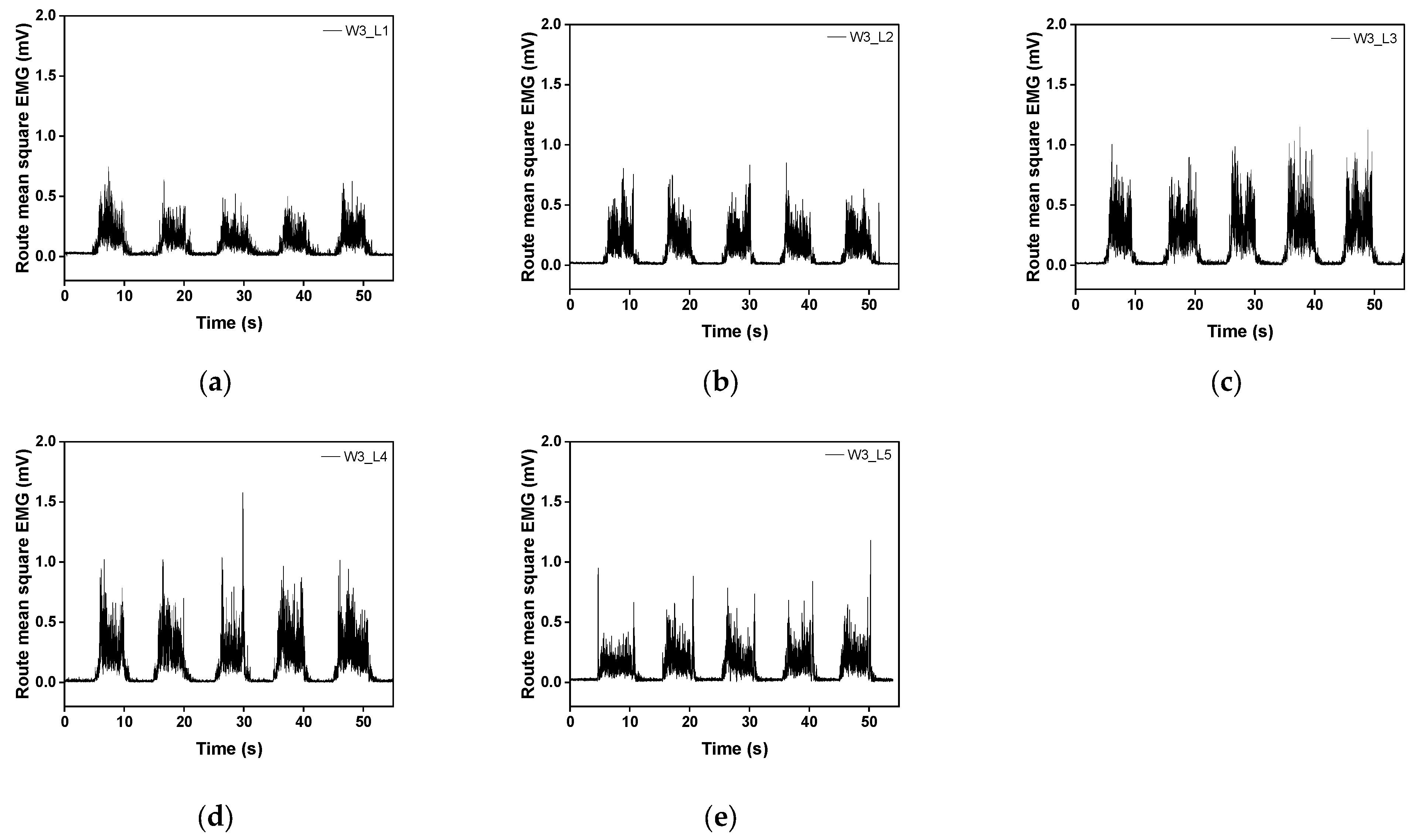
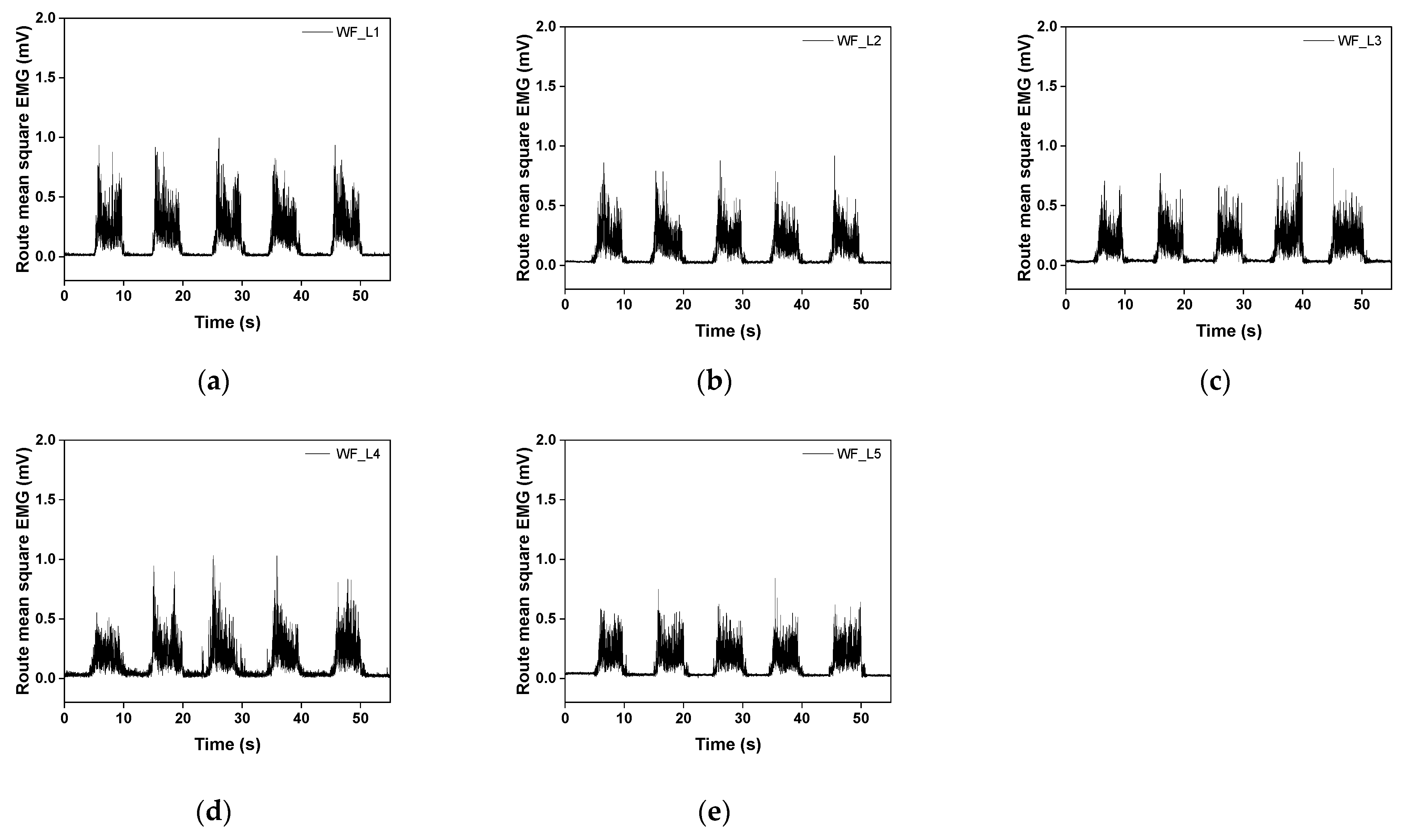
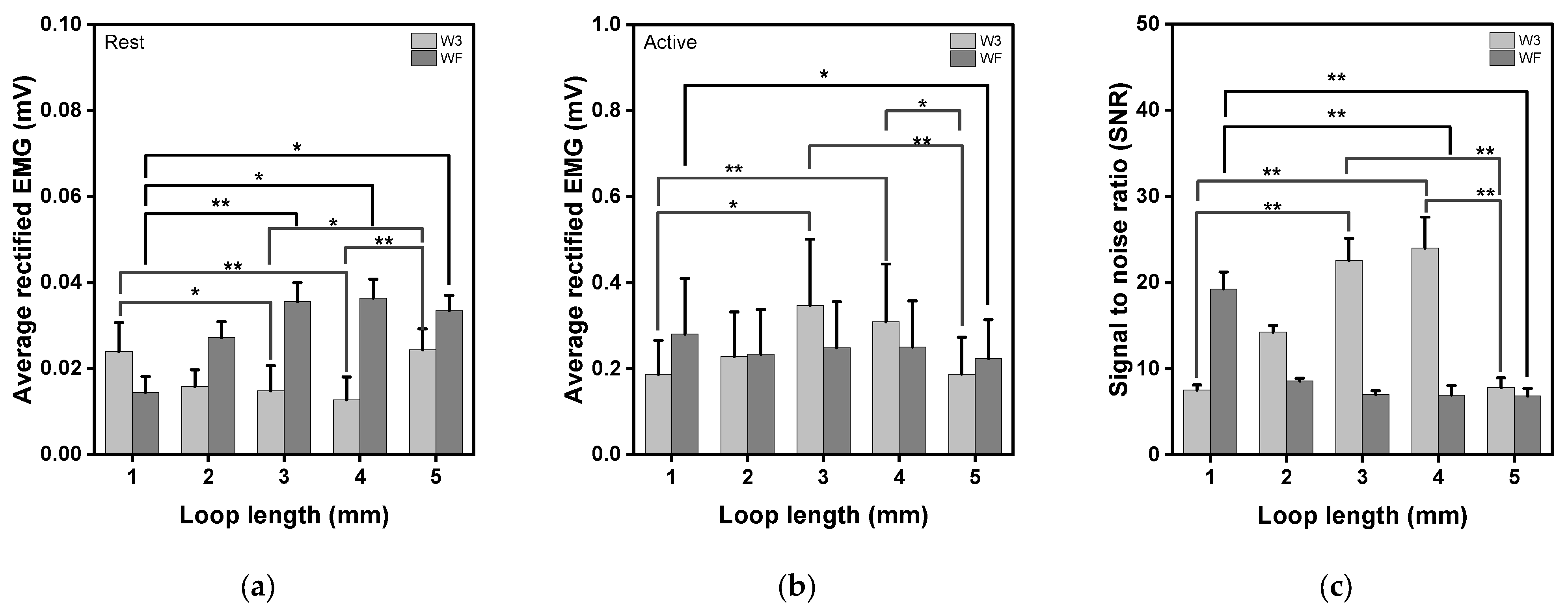
| Sample Code | W3_L1 | W3_L2 | W3_L3 | W3_L4 | W3_L5 | WF_L1 | WF_L2 | WF_L3 | WF_L4 | WF_L5 |
|---|---|---|---|---|---|---|---|---|---|---|
| Designed Image |  |  | ||||||||
| Real Image * |  |  |  |  |  |  |  |  |  |  |
| Loop Length (mm) | 1 | 2 | 3 | 4 | 5 | 1 | 2 | 3 | 4 | 5 |
| Shape | Wave 3 Lines | Wave Fill | ||||||||
| Electrode Diameter (mm) | 20 | |||||||||
| ILD (mm) | 1 | |||||||||
Disclaimer/Publisher’s Note: The statements, opinions and data contained in all publications are solely those of the individual author(s) and contributor(s) and not of MDPI and/or the editor(s). MDPI and/or the editor(s) disclaim responsibility for any injury to people or property resulting from any ideas, methods, instructions or products referred to in the content. |
© 2023 by the authors. Licensee MDPI, Basel, Switzerland. This article is an open access article distributed under the terms and conditions of the Creative Commons Attribution (CC BY) license (https://creativecommons.org/licenses/by/4.0/).
Share and Cite
Rho, S.; Kim, H.; Lim, D.; Jeong, W. Fabrication and Evaluation of Embroidery-Based Electrode for EMG Smart Wear Using Moss Stitch Technique. Sensors 2023, 23, 9012. https://doi.org/10.3390/s23219012
Rho S, Kim H, Lim D, Jeong W. Fabrication and Evaluation of Embroidery-Based Electrode for EMG Smart Wear Using Moss Stitch Technique. Sensors. 2023; 23(21):9012. https://doi.org/10.3390/s23219012
Chicago/Turabian StyleRho, Soohyeon, Hyelim Kim, Daeyoung Lim, and Wonyoung Jeong. 2023. "Fabrication and Evaluation of Embroidery-Based Electrode for EMG Smart Wear Using Moss Stitch Technique" Sensors 23, no. 21: 9012. https://doi.org/10.3390/s23219012
APA StyleRho, S., Kim, H., Lim, D., & Jeong, W. (2023). Fabrication and Evaluation of Embroidery-Based Electrode for EMG Smart Wear Using Moss Stitch Technique. Sensors, 23(21), 9012. https://doi.org/10.3390/s23219012






